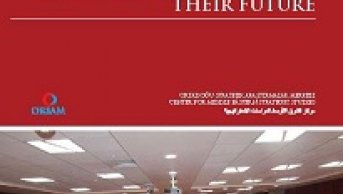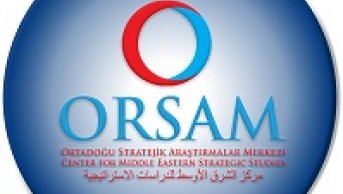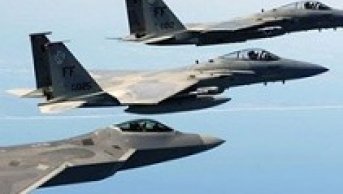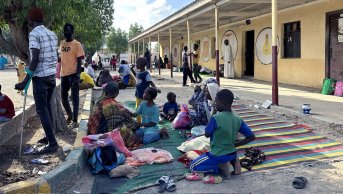Three Days in Syria Observations from Aleppo
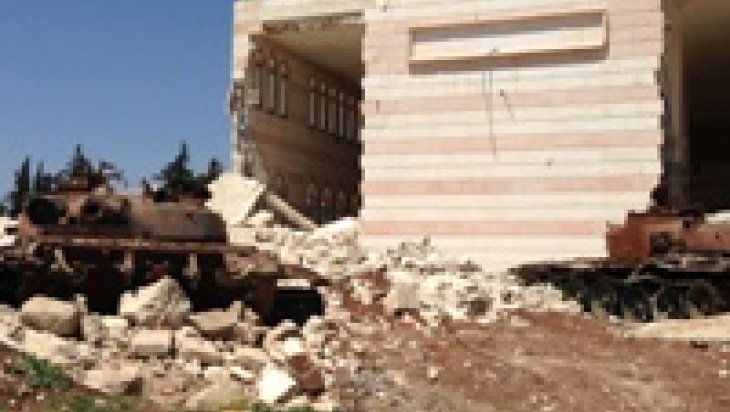
Within the framework of a field study carried out to understand the impact of the humanitarian dimension of the Syrian events on Turkey and to assess the situation in Turkish towns on the border with Syria, we had the opportunity to visit Syria.
We carried out research in Arab, Kurdish and Turkmen settlements located near the Turkish border of Aleppo province by talking to local people and armed opposition fighting the Syrian regime.
In this study, you will find observations from the Turkish border crossing with Syria as well as observations from Syria. It should be taken into consideration that our observations are limited to the areas visited, and that generalizations should not be made about Syria.
After passing through a border gate in Turkey, there is approximately a kilometer-long buffer zone until the Syrian border crossing. A Syrian refugee camp is located here, which is not under Turkey’s control but where Turkish nongovernmental organizations supply aid. The refugee camp, which consists of tents provided by the United Nations High Commissioner for Refugees (UNHCR), is in such a bad state that it bears no comparison with the conditions of refugee camps in Turkey. The camps in Turkey are much better in terms of their organization, social areas, hygiene and security. It is most likely that Syrians here want to go to the camps in Turkey, but right now there is no tent available because of their limited capacity.
Another point that attracts attention on the Turkish side of the border gate is that every Syrian citizen with a passport is allowed to cross the Turkish border. However, armed people are not let in. The groups that control the Syrian side of the border crossing take the arms of soldiers of the Free Syrian Army (FSA) who want to cross the Turkish border. But it would not be wrong to suggest that this control is quite loose. Opposition soldiers on the Syrian side of the border only confiscate the arms that are obvious, but they do not thoroughly check the vehicles nor search the people who cross the border. Thus, it seems possible people can progress to the Turkish border crossing carrying arms or even bombs. Even though there are strict controls in place at the Turkish border crossing, there is a large gap in security while passing the Syrian checkpoint. This situation creates a big security risk for the Turkish border crossing.
Another point that attracts attention at the Syrian border crossing is the presence of aid trucks and those who work for nongovernmental organizations coming from various regions of the world. Many Turkish and foreign NGOs deliver aid to various groups in Syria. And the Syrian group that gets the aid package is responsible for delivering the contents, which are given to groups across Syria they trust or are in contact with. Therefore, Syrian opposition forces pursue a method that is wide open to abuse. Many claims of abuse have been mentioned to us by Syrians. In addition, there is something else that gets our attention. Different nongovernmental organizations put their banners on the same truck; thus, there are different NGOs promoting themselves on the same aid truck.
The influence of the Al-Nusra Front
After crossing the Syrian border, the first settlement you see is Azaz, which is located right across from Kilis. This area is literally dead. It is full of destroyed buildings, devastated tanks and houses displaying obvious signs of conflict. The vast majority of the Azaz residents have left the city. It is estimated that the city’s population has decreased from 50,000-60,000 to around 10,000. There are few people and children on the streets. The regime has completely lost control of the area, but the air strikes and missile attacks continue. Nobody walks the streets at night. There are two factors regarding the security risk: First, the regime might drop bombs on the areas where it has lost control. Second, due to the lack of public authority, petty crime has been on the rise and even kidnapping has become commonplace.
After entering Syria, the first thing we see is a vehicle with soldiers belonging to Ahrar al-Sham, a prominent armed Salafi group. The flags on the front of the vehicles that the armed groups drive indicate their affiliation. From time to time, civilians also fly the flag of an armed group on their vehicles to show their support for a particular group. It is understood that the most influential forces in the rural areas of Aleppo are Salafi groups and the al-Nusra Front. Our observation is based on interviews we conducted and what we saw on the streets. A district might not be controlled by a single opposition group. Different armed groups might keep up their activities in the same area.
There are two different views on the influence of the al-Nusra Front. According to one view, the group comprises fighters mostly coming from outside of Syria, and it is the major actor of the struggle against the regime; it is even alleged that the number of groups fighting against the regime would decrease to a great extent if it weren’t for the al-Nusra Front and some Salafi groups. Hence, it is believed that Salafi groups and the al-Nusra Front continue to fight against the armed groups and have also begun to get involved in crime.
In addition, with their increased confidence due to their success against the regime, these groups have started to establish a way of life to their own liking in the towns they control. Their interference in social life, such as destroying tombs because according to their interpretation of the religion, tomb visiting is against Islam, and the oppressive way in which they try to govern is drawing negative reactions from residents.
Based on the impressions we had as a result of interviews, it appears that everybody tries to keep away from the al-Nusra Front and Salafi groups and that they are fearful about saying anything negative about them. It is possible to claim that those groups are the most powerful ones in Aleppo and especially in Al-Raqqa.
The rivalry among opposition groups in Aleppo
In the rural areas of Aleppo, the control of the regime is limited to some military bases and certain villages with a Shiite population. Therefore, the armed opposition prefers to have all its resources and manpower in Aleppo, which is the main conflict area, rather than allocate money, arms and fighters to those rural areas where there is no close combat. It is not possible to come across opposition forces in the villages and towns of Aleppo. Checkpoints have been created between settlements and in the entrance of villages. There are few soldiers at those checkpoints. Former police or intelligence offices of the regime in settlements are now used by military troops who have seized control of that area. However, there aren’t many soldiers around because those troops say that they have sent most of their soldiers to central Aleppo. Nevertheless, those soldiers still provide the security for that village or town and they cooperate with civil authorities.
The FSA troops fighting in Aleppo believe that the FSA in Homs is making a strategic mistake. They assert that the opposition in Aleppo is in attack mode and that the regime is in defense mode, whereas in Homs the regime is in attack mode and the opposition is in defense mode. According to them, it is due to the fact that the opposition in Aleppo adopted the strategy of heading towards central Aleppo after seizing control of the rural areas, while the opposition in Homs adopted the strategy of first seizing central Aleppo and then spreading towards the rural areas. The opposition fighters from Aleppo assert that it is possible to seize central Aleppo by seizing the rural areas, and that the other way around is too hard. It is alleged that the entire Al-Raqqa province, except for two neighborhoods in the rural area, is under control of the opposition.
It is too dangerous to go to central Aleppo, but the opposition forces keep us informed of developments here. Approximately 60 percent of the city has been seized by the opposition, and 40 percent by the regime. The close combat in the city center has calmed down; both opposition and regime forces maintain their presence on their own sides where they have seized control, without interfering with each other. Therefore, it can be suggested that currently a certain balance of power has been established in central Aleppo. However, if it continues like that, it is claimed that it would be very hard for the opposition forces to seize the whole city. Borders have been drawn between the parties, and neither does anything at this point. However, the regime is in a more advantageous position, as it has the capacity to pound opposition forces by shelling and bombing by jets if necessary. For that very reason, the armed opposition thinks that declaring a no-fly zone could change the balance of power.
In the rural areas of Aleppo, the main dynamic of the conflict is the rivalry among the opposition groups since the regime has completely withdrawn from the area. After eliminating the common enemy, there has been an increase in crime among the groups. The most similar example is the conflict that took place in Çobanbey village, which is predominantly Turkmen. The Arab armed forces, under the name of the Revolutionary Guards, raided the Kocaeli Turkmen village under the administration of the Çobanbey subdistrict of Aleppo, killing three members of one family and taking some children from the village as hostages as a result of a land dispute. In a conflict that took place later on, a solider from the Arab troops was killed in the conflict. It is asserted that such conflicts have taken place among the opposition groups in the recent period due to the lack of authority in the rural areas of Aleppo and also due to the fact that the armed opponents do not recognize any superior authority. There is no revolutionary movement against the Bashar al-Assad regime in those areas.
Gen. Salim Idris has no influence over aid or arms
According to another allegation, which holds that certain opposition groups are also after their own financial interests in the midst of the civil war, the humanitarian aid delivered by Turkey to some groups in Syria was sold instead of being freely distributed to local people by those groups. It is also alleged that tons of food have been stored and sold in many other areas. More interestingly, because the humanitarian aid delivered by Turkey is sold back to Turkey by those groups, it is claimed that the aid coming from Turkey re-enters the Turkish market and thus the prices of staples such as sugar, etc., have decreased in the border towns of Turkey. There are civilian local councils, along with the FSA, in the areas seized by the Syrian opposition forces. On the building of the civilian local council in Azaz someone has written “Thieves.” When we asked why this was written, people told us that the local residents believe the aid being delivered for them is stolen by the local council. Thus, the allegations we had already heard are confirmed by the Syrian people.
Going from Ayn-al Arab (Kobane), a Kurdish settlement, towards the east is where the Arab and Turkmen line begins. However, those areas are by no means the districts where only Turkmens or Arabs live. There are also some Kurdish villages on this line, if not a lot. Furthermore, even in villages with a Turkmen and Arab population, Kurds are in the minority. There are two contradicting views on the Kurds who live in this village. According to the first view, Kurds living within the Arab-Turkmen line have lost their language and they live together in harmony with the Turkmen-Arab population and speak Turkish. Like Arabs and Turkmens, the Kurdish population here is against the Syrian regime, and they act in unison with the FSA. Moreover, they keep the Democratic Union Party (PYD) and radical Kurdish nationalist views at a distance. However, according to another view, this attitude is a tactical one stemming from living in a place with an Arab-Turkmen majority. Even if not as strong as in the areas with a Kurdish-majority population, Kurds living in this area also maintain their Kurdish identity to a great extent, and they have a Kurdish nationalist approach. If the power balance in the region changes, their status might change suddenly and radically.
It is understood from the interviews conducted with military commanders of the armed opposition that they have no responsibility to the Supreme Military Council established in Antalya. In fact, even the commanders in decision-making positions assert that Salim Idris, chief of staff of the Supreme Military Council, plays merely a “messenger” role and does not have any influence over where to send financial aid and arms. Local commanders say they are by no means at the command of Idris and that a central structure could not be formed. It is believed that there might have been a chance to be centralized if the Supreme Military Council could have taken control of finances. However, it is understood that none of the groups, including the commanders who are currently in the council, recognize either Selim Idris or the Supreme Military Council as a superior authority, and they consider it a dysfunctional structure.

